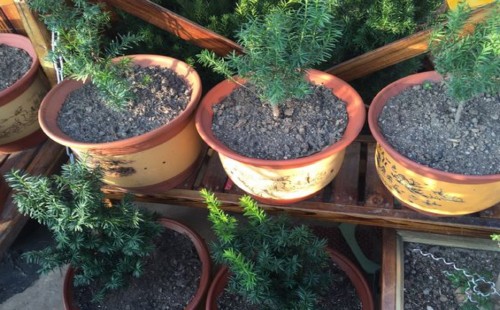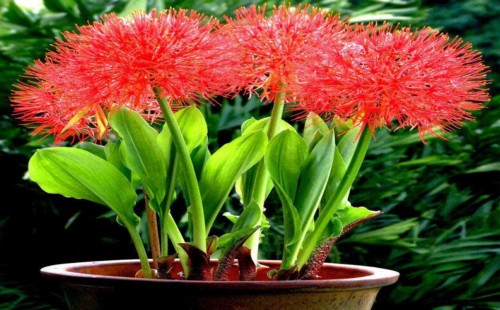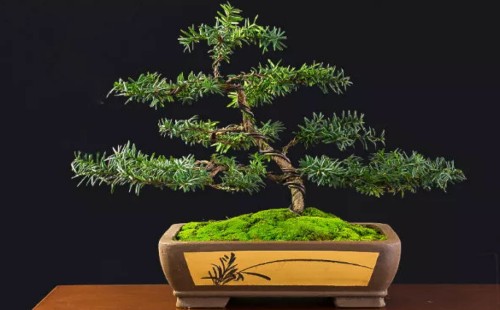How to move the basin after the rotten roots of the yew?
The bonsai of yew is elegant and beautiful, and it is very durable, but the daily maintenance and management must be done well, otherwise it may have a negative impact on growth and reduce the ornamental value. One of the more common phenomena is rotten roots, and the reasons for rotten roots are often varied, generally due to improper management of water and fertilizer. For the phenomenon that the degree of rotten root is relatively mild, we only need to adjust the maintenance and management strategy to save it, but if the degree of rotten root is deep, we can only move the basin. So, how to move the basin after the rotten roots of the yew?

The phenomenon of rotten roots in yew bonsai is mainly due to excessive watering or excessive fertilization. Because the yew is drought-tolerant but not waterlogged, if overwatering leads to stagnant water in the basin, it will inhibit the respiration of the roots, resulting in hypoxia and rotting roots. If the fertilization is excessive, especially after the concentration is too high and raw fertilizer is applied, it is often easy to cause fertilizer damage, and the direct consequence is the phenomenon of rotten roots. If the rotting root caused by improper water and fertilizer management is more serious, it may endanger the life of the yew, so in this case we need to move the basin in time to save it.
I. de-basin treatment
First of all, we need to take the yew out of the original basin, the most simple and direct way is to gently break the original basin, and then we can easily take the yew out of the basin. But if you think it's a pity to knock off the original pot, you can also gently tap around the outer wall of the flowerpot and then turn it upside down, hold the flowerpot in one hand, hold the yew in the other, and then gently take it out.
2. Pull out the soil
After the yew is removed from the original basin, we need to pull out the moist soil or overfertile soil that adheres to the root in time. However, care should be taken in the process of pulling out the soil, because the root system of the plant itself has rotted, so the operation should be light to avoid secondary damage to the root system, and the root system should be protected as much as possible.
Third, clean the roots
After cleaning the soil from the root of the yew, rinse the root with clean water to wash away the residual soil, impurities, and even residual fertilizer in order to facilitate the next step of root trimming. Until the roots of the yew are clearly visible and washed.
4. Pruning and drying roots
After cleaning the roots of the yew, use sterilized scissors to cut off the damaged and original rotten parts of the roots until all the rotting parts of the roots are cut off. Then set it aside to dry the roots for a while.
5. Sterilization and disinfection
After pruning and drying the roots, apply some substances such as plant ash to the roots of the yew to prevent infection and promote wound healing. Of course, the roots can also be dipped with fungicides such as carbendazim. Then put it aside and prepare to plant it again.
VI. Preparation of soil
Taxus likes fertile, porous and permeable acid sandy soil environment, the PH value can be controlled between 5-6.5, ordinary loam can be mixed with peat soil and perlite according to a certain proportion. Before use, the mixed substrate can be soaked to maintain a certain humidity suddenly, so as to avoid the humidity needed for growth due to watering of the replanted yew, thus avoiding the risk of root wound infection caused by watering during planting.
7. Planting in pots
After all the preparations are in place, we can replant the yew with rescued roots in the flowerpot. The planting process is basically the same as that of many other tree species. After re-potting, you can put it in a cool place to slow down the seedlings. During this period, special attention should be paid to avoid direct sunlight, and when the basin soil dries, it is advisable to spray water to the plant to keep it moisturized. As long as we can strictly manage in accordance with the standard steps, I believe it will not take long for the yew to take root and sprout.
However, it should be noted that due to the serious damage to the roots of Taxus, the roots are unable to transport nutrients and water to the trees in time, and moving pots will also make the plants adapt to the new environment and require a basin-taking process, so the roots of Taxus chinensis will basically lose their absorbing capacity in a short period of time. In view of this, in order to reduce the burden on the roots, we need to prune the branches and leaves of the plant in time, especially those withered branches and leaves should be cut off to reduce the consumption of water and nutrients. This treatment will promote the revival process of Taxus mairei to a great extent.
Time: 2019-05-29 Click:
- Prev

Why does potted Lycoris not blossom in the north?
Garlic flower, also known as the other shore flower, because of its bright red flowers, people can not help thinking of blood, although the flower shape is beautiful, but in the folk people think that its flowers have ominous beauty, symbolizing disaster and death. But the garlic flower is, after all, a strange flower plant, and its leaves are usually not seen when it blossoms.
- Next

How to resurrect the rotten roots of yew
Many bonsai friends like to raise bonsai trees at home, which can not only be watched, but also bring a touch of freshness and greenness to the environment, but in the process of daily maintenance and management, the most disturbing thing is a series of bad growth phenomena caused by the rotten roots of bonsai trees. there may even be a fatal phenomenon. If it is not handled properly
Related
- Fuxing push coffee new agricultural production and marketing class: lack of small-scale processing plants
- Jujube rice field leisure farm deep ploughing Yilan for five years to create a space for organic food and play
- Nongyu Farm-A trial of organic papaya for brave women with advanced technology
- Four points for attention in the prevention and control of diseases and insect pests of edible fungi
- How to add nutrient solution to Edible Fungi
- Is there any good way to control edible fungus mites?
- Open Inoculation Technology of Edible Fungi
- Is there any clever way to use fertilizer for edible fungus in winter?
- What agents are used to kill the pathogens of edible fungi in the mushroom shed?
- Rapid drying of Edible Fungi

